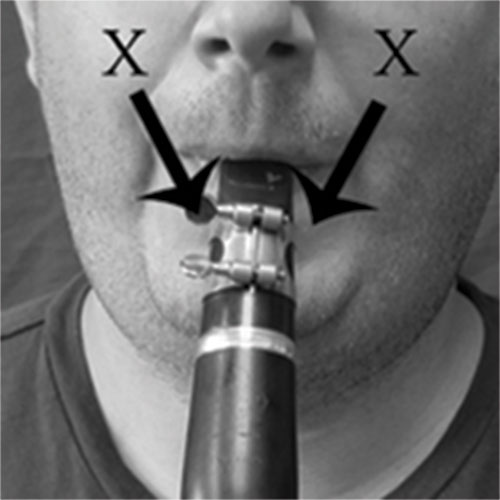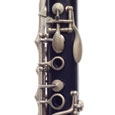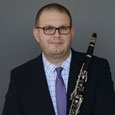From the time they are young, many clarinetists feel insecure about playing in the higher register of the instrument. However, intelligent practice of these higher notes will not only dramatically improve the end result but also promote a sense of security while playing. As a clarinetist I have three goals that I keep in mind whenever I play, especially when I begin playing in the altissimo register. Although they are seemingly simple, these goals help guide me to the best possible solution when a problem does arise.

- Strive to play with a homogenous sound through the entire range of the instrument. No note should stick out as sounding different.
- Promote stability by allowing the least amount of change or manipulation necessary to produce the desired result. Minimize the visible embouchure movement as well as the movement of the tongue.
- Convey a sense of ease to the listener at all times. Keep the air moving in a fast, relaxed stream so everything sounds effortless.
Altissimo Notes Do Not Speak
Occasionally a high note will not speak while playing. This happens to even the best clarinetist from time to time, so it is important to have a basic troubleshooting procedure. Follow these steps in the listed order.
Verify the fingering. It is amazing how often an incorrect fingering causes the problem. This solution should be considered before anything else; an incorrect fingering will not work. Once it has been verified that the fingering is correct, work to be able to use it with both confidence and ease. Hesitating can cause problems. Additionally, it is important to ensure the holes are completely covered using the pads of the fingers.
Air. Once it has been verified that the fingers are not to blame, make sure the air is fast and well-supported. Clarinetists can become so concerned with a fingering that they lose focus on their air or tense up while playing.
Reed strength. Before considering a change to the embouchure, make sure that the reed is strong enough. If a reed is too soft, high notes might not speak because the reed can close against the mouthpiece facing and stop vibrating. To be sure this is not the case, try putting on a different, slightly harder reed to see if that permits the high note to speak more easily. Remember that when a reed is played for an extended period of time it will soften. Thus, a reed that was of adequate strength when it first came out of the box, will eventually become too soft after considerable use.
Consider the embouchure. If nothing else solves the problem, the embouchure might not be allowing the reed to vibrate correctly. First, check that the bottom jaw does not pull away from the reed as one plays the altissimo notes. Pulling the jaw away can prevent the reed from vibrating sufficiently. The top and bottom teeth should be more or less aligned. If the bottom teeth fall behind the top teeth, the amount of reed vibrating decreases significantly. Relax the bottom jaw forward, gently towards the reed, so that the bottom teeth are more in line with the top teeth.
Placing too little mouthpiece inside the mouth can also cause the reed to vibrate incorrectly. Identify the fulcrum point on the mouthpiece, which is where the mouthpiece facing starts to slope away from the reed. The lower lip should contact the reed just above this point. An easy way to find the fulcrum point is to slip a piece of notebook paper between the reed and mouthpiece facing. The paper will stop right at the fulcrum point, giving a clear picture of the correct amount of mouthpiece to place in the mouth.
Altissimo Notes Are a Struggle, and Notes in the Clarion Register Often Come Out Flat
This is a common problem, particularly with younger players who are relatively new to playing in the altissimo register. If this happens, first check that the reed is hard enough. If the reed is too soft, the embouchure must nearly collapse to allow any notes to speak. This embouchure collapse often causes both pitch and tone quality to sag flat.
If the reed is an appropriate strength but the pitch still goes flat, ensure that the embouchure is held firmly against the teeth. The embouchure should always form firmly around the musculature of the face. This is not to imply that the lips are locked into place rigidly, but simply that they are held taut against the face. Too often, players form their embouchure around the mouthpiece and reed, rather than inserting the mouthpiece into the aperture created by the embouchure. This can allow the pitch to fall flat as the lips rest lazily against the mouthpiece and reed. Instead, practice forming the embouchure without the clarinet in the mouth and gently press against the embouchure with a finger to be sure the lips are held firmly. Then, place the mouthpiece into this embouchure.
Altissimo Notes Speak but Are Pinched and Tend to Be Sharp
This is usually caused by excessive upward jaw pressure. To fix it, form an embouchure without the clarinet. Put an index finger on each cheekbone (the X in the diagram in the next column) and draw the lips firmly down against the face towards the chin from these two points. The chin should be pointed down and slightly forward while the lips are drawn down to the chin itself. By grounding this motion from these two points you help train yourself to form the embouchure around the face. Once you find this position, blow shh as if you are playing the clarinet. Try to keep the air moving fast with a shh sound while drawing the lips down towards the chin. If done correctly, the chin should appear flat and drawn down to a point.

Refining the Quality of the Altissimo Register
Many people can get the altissimo notes to speak reliably, but the quality is not as refined as the chalumeau or clarion registers. In this case, I would suggest practicing a few different ways.
Practice the passage down an octave. After years of playing, we become so accustomed to how we normally sound that we can easily stop critically assessing the tone quality. To see how the tone is being compromised, practice a passage down an octave several times with a full, resonant tone. Next, try to play with the same quality of sound in the printed octave. Alternate between the two octaves until both have the same quality of sound. The goal should always be to produce the desired sound rather than accept the sound that comes out through happenstance.
Practice playing opposite the desired dynamic. It can be difficult to make the tone as full at piano as it is at forte. Conversely, when playing forte, the sound can get a bit strident in a way that does not happen when playing piano. Practicing a passage at the opposite dynamic can help students develop more control over the tone quality and use their ears to identify exactly where a problem may lie.
Practice playing register skips without any embouchure movement. Legendary clarinetist Daniel Bonade suggested practicing register skips in this manner to help find more flexibility in the tone.
.jpg)
While playing the example take a breath only where printed. Try not to allow any visible movement in the embouchure and try to make as much dynamic contrast as possible. In many years of teaching I have found that this simple exercise helps correct a number of fundamental problems, and I recommend that clarinetists make this exercise a part of their regular practice routine.
Conclusion
Refining the quality of sound in the altissimo register is an undertaking that never ends for clarinet players. To grow as clarinetists, students must work to play with the same ease and tone quality across the range of the instrument.






